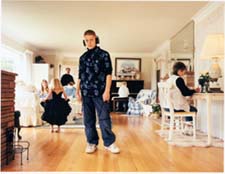 | |
| { Melwood Photography Gallery's Suburban Dreams } Leslie Hoffman photo courtesy Pittsburgh Filmmakers The first suburbs began after World War II outside New York City with a small pre-fab housing plan called Levittown. Its rows of boxy, analogous houses were then a phenomenon, but in the past fifty years, the suburb has become a stereotype, an American fixture. Today, suburbs are a haven for the wealthy and comfortable middle class, and though the subdivisions of the suburbs still maintain some uniformity, they have grown beyond simple caricatures of homes to large, safe, elaborate and carefully groomed communities. | |
